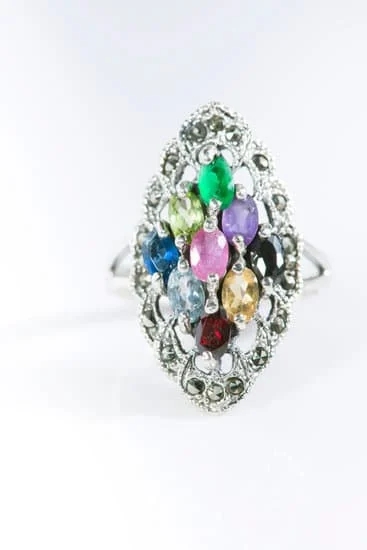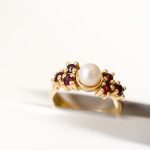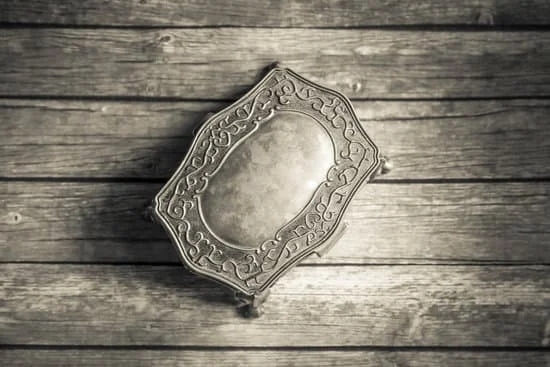Beading jewelry has become increasingly popular in recent years, allowing individuals to create stunning and personalized pieces that reflect their style and personality. In this article, we will explore the art of beading jewelry, providing you with step-by-step instructions and tips on how to create your own unique designs.
So, what exactly is beading jewelry? Beading jewelry refers to the technique of using beads to create various types of accessories such as necklaces, bracelets, earrings, and even rings. This art form allows you to unleash your creativity and express yourself through intricate designs and beautiful color combinations.
One of the reasons why beading jewelry has gained such popularity is its versatility. Whether you prefer a bohemian look or something more elegant and refined, there are endless possibilities when it comes to beaded jewelry. And the best part? You can customize your creations to match any outfit or occasion.
In this article, we will guide you through the process of creating your own stunning beaded jewelry. We will start by discussing the essential materials needed for beading jewelry and provide options for different styles and designs. Additionally, we will delve into the importance of a well-organized workspace and offer tips on setting up a functional beading station.
So grab your beads and let’s get started on this exciting journey into the world of beading jewelry.
Materials Needed for Beading Jewelry
When it comes to creating beading jewelry, having the right materials is essential. The materials you choose can greatly impact the overall design and durability of your jewelry pieces. Here are some essential materials you will need to get started with beading jewelry.
- Beads: Beads are the focal point of any beading jewelry piece. There are endless options when it comes to choosing beads, including glass beads, gemstone beads, acrylic beads, metal beads, seed beads, and more. Consider the size, shape, color, and texture of the beads to create a unique and eye-catching design.
- Stringing Material: The stringing material is what holds all the beads together in your jewelry piece. Some popular options include beading wire (e.g., nylon-coated stainless steel wire), silk thread, beading cord, and stretchy cord for bracelets. Choose a stringing material that suits your design and provides sufficient strength and flexibility.
- Findings: Findings are essential components that help complete your jewelry piece and provide functionality. This includes clasps (e.g., lobster clasps, toggle clasps), jump rings (used to attach components together), ear wires (for earrings), bails (for pendants), headpins or eyepins (to create dangles or loops), crimp beads or tubes (to secure the ends of beading wire), and bead tips (to protect stringing material).
- Tools: To create beautiful beading jewelry pieces, you will need some basic tools like needle-nose pliers, round-nose pliers, wire cutters or scissors (for cutting stringing material), crimping pliers (for securing crimp beads or tubes), and bead mats or trays (to keep your workspace organized).
- Other Supplies: Depending on your chosen techniques and designs, you may also need other supplies such as beading needles (for stitching techniques), beading looms or frames (for weaving), bead boards or design trays (to plan and lay out your design), and adhesive (e.g., jewelry glue, E6000) for attaching certain components.
Remember that the materials you choose should not only be visually appealing but also of good quality. It is worth investing in high-quality beads, findings, and tools to ensure the longevity of your jewelry pieces. Experiment with different materials and combinations to create one-of-a-kind designs that reflect your personal style and creativity.
Preparing Your Workspace
Having a well-prepared and organized workspace is crucial when it comes to beading jewelry. Not only does it allow you to work efficiently, but it also helps in preventing any mishaps or accidents. Here are some tips on how to prepare your workspace for beading jewelry:
- Find a Well-Lit Area: Adequate lighting is essential for beading jewelry as it allows you to see the details of your work clearly. Choose a workspace that has natural light during the daytime, or consider investing in good-quality task lighting if you’re working at night or in a dimly lit area.
- Organize Your Beads: Before you begin any project, make sure that your beads are properly organized and easily accessible. Sorting them by color, size, or type can save you a lot of time and frustration later on. You can use small plastic containers, bead organizers with multiple compartments, or even a bead storage system with labeled drawers.
- Set Up a Beading Station: Dedicate a specific area in your workspace as your beading station. Use a table or desk that is comfortable for you to work on and has enough space for all your materials and tools. Consider using a bead mat or felt cloth to prevent beads from rolling around and getting lost.
- Gather Your Tools: Make sure that all the necessary tools for beading jewelry are within reach at your workstation. These may include needle-nose pliers, wire cutters, crimping pliers, thread snips, bead stoppers, and various needles depending on the techniques you’ll be using.
Creating an organized and well-lit workspace not only sets the stage for successful beading projects but also enhances your overall experience of making jewelry. Taking the time to prepare your workspace will streamline your workflow and ensure that you have everything you need readily available.
| Tips for Preparing Your Workspace |
|---|
| Find a well-lit area |
| Organize your beads |
| Set up a beading station |
| Gather your tools |
Basic Techniques for Beading Jewelry
When it comes to creating beading jewelry, mastering the basic techniques is essential. These techniques serve as the foundation for more intricate designs and can help you bring your creative visions to life. Whether you are a beginner or have some experience with beading, understanding these techniques will open up a world of possibilities for your jewelry creations.
- Stringing: Stringing is one of the most common techniques used in beading jewelry and involves threading beads onto a string or wire. To get started, gather your desired beads and a strong beading thread or wire. Begin by attaching a clasp to one end of the thread using a crimp bead or knot.
Then, thread on your beads in the desired pattern, making sure to leave enough length on both ends to attach another clasp. Finally, secure the second clasp using another crimp bead or knot. - Weaving: Weaving techniques allow you to create intricate patterns and designs in your beading jewelry. One popular weaving technique is peyote stitch, which involves stitching rows of beads together using needle and thread. To start, string on an even number of beads and create a circle by passing the needle through the first bead added.
Then, use an over-under motion to weave through each subsequent bead until you complete the row. Continue adding rows until you achieve your desired length or design. - Stitching: Stitching techniques involve sewing beads together using needle and thread to create various patterns and textures in your jewelry pieces. Brick stitch is a versatile stitching technique that can be used to create earrings, pendants, or even bracelets. To begin, secure a stopper bead at the end of your thread and then string on three beads in an alternating pattern (up through one bead, down through another).
Pass the needle back up through all three beads again to form a loop. From here, continue adding rows of brick stitch by sewing through the beads in each row.
By mastering these basic beading techniques, you can create a wide range of jewelry pieces that showcase your unique style and creativity. Experiment with different bead sizes, colors, and materials to add variety and depth to your designs. With practice and patience, you’ll soon be able to incorporate more advanced techniques into your repertoire and take your beading jewelry skills to the next level.
Choosing the Right Beads and Colors
Choosing the right beads and colors is a crucial step in creating beautiful beading jewelry. With so many options available, it can be overwhelming to make choices that complement each other and bring your design vision to life. In this section, we will discuss the different types of beads available and provide guidance on selecting beads and colors for your beading jewelry.
When choosing beads, consider the style and theme of your jewelry piece. There are various types of beads to choose from, including seed beads, gemstone beads, crystal beads, glass beads, metal beads, and ceramic beads. Each type of bead offers different textures, shapes, sizes, and finishes that can enhance your design. Experiment with mixing different bead materials to create a unique look.
Color selection is also an important aspect when choosing beads for your beading jewelry. Consider the overall color scheme and aesthetic you want to achieve.
You can opt for monochromatic designs using shades of a single color for a cohesive look or go for contrasting colors to create visual interest. Pay attention to complementary colors (colors opposite each other on the color wheel) or analogous colors (colors next to each other on the color wheel) that can create harmony in your design.
To help visualize how different bead combinations will look together, it can be helpful to create a sample board or use online resources that allow you to digitally experiment with various bead colors and combinations. Don’t be afraid to try different options until you find the perfect combination that aligns with your design vision.
Remember that choosing the right beads and colors is an iterative process. It may take some trial and error before finding the perfect combination for your specific project. Explore different possibilities, trust your instincts, and have fun experimenting with different bead types and color palettes to create stunning beading jewelry pieces.
Designing Your Beading Jewelry
When it comes to creating beading jewelry, the design process is key. Designing your own pieces allows for personal expression and the ability to create unique and one-of-a-kind jewelry that reflects your style and personality. In this section, we will delve into the importance of planning and sketching your designs, as well as offer tips on creating aesthetically pleasing jewelry pieces.
Planning and Sketching
Before diving into the bead selection and assembly process, it is crucial to have a clear plan in mind for your design. Planning allows you to visualize the final piece before you begin creating it and helps avoid mistakes or rework down the line. Consider the style, theme, or occasion for which you are creating the jewelry. Do you want a statement necklace or delicate earrings? Understanding your desired outcome will guide you in selecting appropriate beads and techniques.
Once you have a basic idea of what you want to create, sketch out your design on paper or use digital design tools available online. A sketch serves as a blueprint for your project and helps organize your thoughts. Include measurements, bead arrangements, and any additional elements such as charms or pendants. This step helps ensure that all components fit together harmoniously before starting to string beads.
Tips for Creating Unique Jewelry Pieces
Beading jewelry is an art form that allows for endless creativity. Here are some tips to help you create unique and visually stunning pieces:
- Experiment with Different Bead Sizes: Incorporating different sizes of beads adds dimension and visual interest to your designs. Mix small seed beads with larger accent beads or focal pieces.
- 2.Combining Different Types of Beads: Don’t limit yourself to just one type of bead; mix various materials like glass beads, gemstones, crystals, or wood beads to add texture and variety to your designs.
- 3.Color Theory: Consider color combinations that work well together. You can choose complementary colors that are opposite on the color wheel for a vibrant contrast or opt for analogous colors that are adjacent to each other for a more harmonious look.
- 4.Adding Embellishments: Explore adding charms, pendants, or even tassels to your designs for an extra element of charm or playfulness. These embellishments can elevate a simple design and make it truly unique.
Remember, designing beading jewelry is a journey of exploration and self-expression. Allow yourself to think outside the box and let your creativity flow. By planning your designs in advance and incorporating various elements and techniques, you can create stunning pieces that truly reflect your personal style.
Finalizing Your Beading Jewelry Creation
Once you have completed the design and construction of your beading jewelry, it is time to add the final touches that will enhance the overall look and functionality of your piece. This section will guide you through the steps of finishing your creation, including choosing the right clasps, findings, and closures, as well as properly securing and reinforcing your jewelry.
Choosing the Right Clasps, Findings, and Closures
When it comes to selecting clasps, findings, and closures for your beading jewelry, there are a variety of options available to suit different styles and preferences. The clasp is an essential component that not only secures your jewelry but also adds a decorative element. Lobster clasps are versatile and easy to use, while toggle clasps provide a more decorative touch.
Magnetic clasps can be convenient for those with limited dexterity. Additionally, there are various types of findings such as jump rings and crimp beads that are used to connect different components of your beading jewelry.
Properly Securing and Reinforcing Your Jewelry
To ensure that your beading jewelry withstands everyday wear and tear, it is crucial to properly secure and reinforce all the components. Be sure to use appropriate tools such as crimping pliers or needle-nose pliers to securely fasten your findings. If you are working with stringing materials like wire or thread, consider using bead tips or knot covers to create a professional finish while protecting the ends from fraying.
In addition to securing individual elements of your design, reinforcing the overall structure of your piece is equally important. Pay attention to tension points where stress may occur during wearing or handling. You can reinforce these areas by adding an extra layer of thread or wire around them or incorporating stabilizing components such as bead frames or bead caps.
By choosing suitable clasps and findings and ensuring the overall strength of your jewelry, you can create a finished piece that not only looks beautiful but also stands the test of time.
Now that you have completed the final touches on your beading jewelry creation, it is time to move on to the next section where we will discuss caring for and maintaining your pieces.
Caring for and Maintaining Beading Jewelry
Once you have completed your beautiful beading jewelry creations, it’s important to know how to properly care for and maintain them to keep them looking their best. With the right care, your jewelry can last for years to come. In this section, we will provide you with some tips on cleaning and storing your beading jewelry, as well as discuss common issues that may arise and how to fix or prevent them.
To begin, let’s talk about cleaning your beading jewelry. It’s important to handle your jewelry with care when cleaning to avoid damage. One simple method is to use a soft cloth or brush to gently wipe away any dirt or dust from the beads and findings.
If you need a more thorough cleaning, you can mix a small amount of mild soap with warm water and use a soft brush or toothbrush to gently scrub the beads. After cleaning, rinse the jewelry in clean water and pat dry with a soft cloth. Avoid using harsh chemicals or abrasive cleaners as they can damage the beads.
When it comes to storing your beading jewelry, it’s essential to keep them away from moisture and sunlight as these can cause fading or discoloration of the beads. One option is to store your pieces in separate compartments of a jewelry box or organizer, ensuring that they do not come into contact with each other which can lead to scratching.
Another option is using small resealable plastic bags for each piece of jewelry before placing them in a storage container.
In addition to cleaning and storage, it’s important to address common issues that may arise with your beading jewelry. For example, if you notice that the thread used in stringing has started to fray or weaken over time, it’s essential to restring the piece before it breaks completely.
This will help ensure that your jewelry remains secure. Additionally, if you have decorative elements such as clasps or closures that have become loose or damaged, it’s important to repair or replace them to prevent further damage to the overall piece.
By following these tips on caring for and maintaining your beading jewelry, you can enjoy your creations for years to come. Remember to handle your jewelry with care, clean it regularly, and store it properly. Should any issues arise, address them promptly to prevent further damage. With proper maintenance, your beading jewelry will continue to shine and bring joy each time you wear it.
Inspiration and Resources for Beading Jewelry
When it comes to creating beading jewelry, finding inspiration and accessing reliable resources is crucial for taking your skills to the next level. Whether you’re a beginner or an experienced beader, exploring different ideas and learning new techniques can help you expand your creativity and enhance your designs. This section will provide you with valuable tips and resources to inspire and guide you on your beading jewelry journey.
One of the best ways to find inspiration for your beading jewelry is to explore online resources. There are countless websites, blogs, and social media platforms dedicated to all things beading. Websites like Pinterest offer a treasure trove of ideas and tutorials, where you can discover unique designs, color combinations, and innovative techniques used by other artists.
Additionally, there are various online communities and forums where crafters share their experiences, tips, and suggestions. Engaging with these communities not only offers inspiration but also provides an opportunity to connect with fellow beaders who share your passion.
Another great way to get inspired is to visit local bead shops or attend craft fairs and exhibitions. These venues often showcase a wide range of beads in different colors, shapes, sizes, and materials that can spark your creativity. Seeing beads up close can give you a better sense of how they will look in your designs and help you discover new possibilities.
To further enhance your skills in beading jewelry making, consider investing in books or signing up for online courses or workshops. There are numerous instructional books available that provide detailed step-by-step guides on various techniques and projects. Online courses offer the convenience of learning at your own pace from the comfort of your home while receiving expert guidance from experienced instructors.
By seeking inspiration from various sources such as online platforms, local shops, books, courses, workshops, and engaging with the wider crafting community, you’ll have an abundance of ideas at your fingertips. Remember that inspiration can come from anywhere – nature, art galleries, fashion trends – so keep an open mind and always be on the lookout for new sources of inspiration. Happy beading.
Conclusion
In conclusion, learning how to do beading jewelry is a rewarding and fulfilling experience. By following the step-by-step instructions and utilizing the various techniques discussed in this article, you can create stunning and unique pieces that showcase your creativity and personal style.
It is important to remember that practice makes perfect, so don’t be discouraged if your first few attempts are not exactly what you envisioned. With time and dedication, you will improve your skills and be able to create even more intricate and beautiful designs.
Once you have completed your beading jewelry creations, it’s time to show them off. Share your work with friends and family, or even consider setting up an online shop to sell your pieces. Participating in local craft fairs or markets can also provide opportunities for others to appreciate and purchase your jewelry. Not only will showcasing your creations allow you to gain recognition for your talent, but it will also serve as a source of inspiration for others.
Above all, enjoy the process of creating beading jewelry. Embrace the joy and satisfaction that comes from working with various beads, experimenting with different colors and patterns, and bringing your ideas to life. The world of beading jewelry is vast and ever-evolving, so continue exploring new techniques, materials, and design concepts to continuously develop your skills.
Whether you choose to make beading jewelry as a hobby or pursue it as a business venture, the possibilities are endless. So pick up those beads, let your creativity soar, and create beautiful works of art that reflect who you are as an artist.
Frequently Asked Questions
What do you need to make beaded jewelry?
To make beaded jewelry, you will need a few essential supplies. Firstly, you’ll need beads of your choice. These can come in various materials such as glass, ceramic, wood, or plastic, and can be found in different sizes, shapes, and colors. Additionally, you’ll require beading wire or thread to string the beads together.
Beading wire is usually made of nylon-coated stainless steel or a flexible material like silk or cotton; it should have enough strength to support the weight of the beads. You’ll also need clasp findings like jump rings and lobster clasps to fasten your jewelry securely. Finally, tools such as wire cutters, round-nose pliers, and crimping pliers are necessary for cutting the wire/thread and creating loops or securing clasps.
How do I start beading?
Starting beading can be an exciting journey into the world of creativity! To begin with beading, it’s helpful to gather some basic information about the craft and find sources of inspiration through books, magazines, or online tutorials. Familiarize yourself with different types of beads available and experiment with color combinations that catch your eye.
Start by choosing a simple project that matches your beginner level skills; consider making a bracelet with elastic cord for easy sizing or working on a necklace using pre-made chains. As you practice and gain confidence in your abilities, you’ll naturally progress to more challenging techniques.
What are the basic techniques of beading?
The world of beading encompasses numerous techniques that allow for endless creative possibilities. Some basic techniques include stringing beads onto thread or wire using knots or crimps to secure them in place; this technique is known as stringing. Another fundamental technique is bead weaving where individual beads are woven together using needle and thread to create intricate patterns and designs like peyote stitch or brick stitch.
Wirework is yet another technique that involves manipulating various gauges of wire into specific shapes and patterns to form earrings, pendants, or other jewelry components. Additionally, bead embroidery combines sewing and beading to attach beads onto fabric or other materials for a textured and decorative effect. Overall, these techniques serve as the foundation for more advanced and specialized beading methods but provide an excellent starting point for beginners to explore their creativity and produce unique jewelry pieces.

Welcome to my jewelry blog! My name is Sarah and I am the owner of this blog.
I love making jewelry and sharing my creations with others.
So whether you’re someone who loves wearing jewelry yourself or simply enjoys learning about it, be sure to check out my blog for insightful posts on everything related to this exciting topic!





